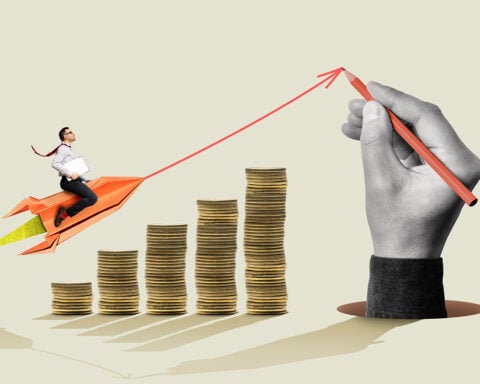Our blueprint aims to guide market players through investing in an unpredictable market.
In contemplating the stock market, investors typically visualize it as either a bull or bear market, exhibiting a clear up or down trend. However, we’ve been experiencing a third kind of market over the past year, one that lacks a clear direction, resembling a trading range or sideways market. An apt animal analogy might be a crab.
The S&P 500 index has oscillated between roughly 3,500 and 4,300 for the past year. However, with only a few outliers, the comprehensive market index has remained within 5% of the 4,000 mark, as Bob Doll, Chief Investment Officer at Crossmark Global Investments, highlighted. This illustrates a balanced contest between bullish and bearish forces, which aligns with Doll’s central 2023 forecast: “Expect a year where neither the bulls nor the bears find satisfaction as the volatility persists in both directions.”
Eventually, the stock market will move beyond its current range, which might happen before the year ends. But in which direction?
Opinions among Wall Street strategists are split, with price target estimations ranging from a high of 4,600 to a pessimistic scenario of 3,500. Multiple forecasts cluster around 4,300 on the upper end (an increase of 3% from the S&P 500’s level of 4,169 on April 30, which is the source of prices and other data used in this article), and approximately 3,900 on the lower end (a decrease of 6%). For instance, Goldman Sachs’ projections for the S&P over the next three months, six months, and year-end are all fixed at 4,000.
However, this doesn’t imply that investors should remain idle for the remainder of the year. The market is never uniform, and despite the possibility of a stagnant broad-market index, individual stocks will experience victories and defeats. To put it another way, conflating a range-bound market with a tranquil one is a mistake.
“Elevated volatility and price choppiness will persist throughout the year as investors grapple with uncertainties such as inflation, Federal Reserve policies, interest rates, earnings, and economic growth,” predicts Brian Belski, Chief Investment Strategist at BMO Capital Markets.
Intelligent investors will leverage the market’s fluctuations, suggests Doll. “Since I believe the market will oscillate without significant progress, I would advocate for buying during declines and trimming during rallies. This strategy applies to stocks, sectors, industries, and the overall market. If I am interested in a stock, I will patiently wait for my price and cut something else to purchase it. This might sound like trading, but it’s a matter of doing due diligence.”
The bear perspective on stocks
Market pessimists, or as they prefer, realists, identify several significant obstacles looming in the market’s future. A recession is a primary concern. According to Crossmark Global, seven of the last nine Fed rate-tightening cycles resulted in a downturn.
Even Ed Yardeni, an economist and market strategist from Yardeni Research, who is among the most bullish with an S&P target of 4,600, estimates a 40% probability of the economy entering a recession in the latter half of the year. He admits, at the very least, that stricter lending standards arising from a recent regional banking crisis could limit credit flow, hence inhibiting growth. “That’s a valid concern,” he concedes. “Maybe this is a consequence of the Fed’s tightening measures.”
Goldman Sachs’ economists assign a 35% chance of a recession in the next 12 months. But if a recession hits, the effects will be severe, warns Goldman’s chief U.S. stock strategist, David Kostin and his team: “If the U.S. enters a recession, we anticipate that the S&P 500 would plummet to 3,150.”
Kiplinger assesses the probability of a recession as a coin toss. If a contraction occurs, it could materialize as early as the third quarter, or later if the labor market’s decline is gradual. For 2023 overall, the GDP is projected to rise by 1.4% if we dodge a recession, or by 1.1% if we don’t.
An earnings recession may already be underway. Even if the broader economy avoids a recession, corporate profits — the fuel that drives stock prices — are likely already in one, defined as a minimum of two consecutive quarters of year-on-year reductions.
The first instance occurred in Q4 2022, when earnings for S&P 500 companies decreased 3% compared to Q4 2021. After companies finalize their Q1 reporting, analysts predict a nearly 2% drop from the same quarter last year. The lowest point is expected to be reached with Q2 earnings reported later this summer, currently forecasted to be more than 4% lower.
The key issue is profit margin squeeze, which peaked in early 2022 and have been shrinking for four straight quarters. With inflation reaching its peak, companies will struggle to transfer price hikes to consumers, warns Saira Malik, Chief Investment Officer at Nuveen. “Pricing has been the linchpin supporting earnings. With unimpressive sales volumes and contracting profit margins, earnings are likely to deteriorate further from here.”
Additionally, escalating geopolitical tensions in regions like Ukraine and China could disrupt the market. “The geopolitical landscape is potentially as perilous as it’s ever been,” Doll warns. “There is a multitude of potential flashpoints.”
The bull perspective on stocks
Recent trends favor the optimists. Despite being flat over the past 12 months, the S&P 500 has grown 8.6% (in price terms) so far this year and surged more than 16% since last October’s market nadir.
The present obsession with forecasting the next recession is counterproductive, argues BMO’s Belski. “The market is so engrossed in making recession predictions that we’ve overlooked that the stock market accounted for this by dropping 25% last year,” he comments.
Due to the anticipation of an imminent recession, it might not materialize, proposes Yardeni, who sees a 60% probability of a soft landing. From a contrarian standpoint, widespread anxiety is advantageous. “The market thrives on climbing a wall of worry. It’s advantageous that so many people anticipate a recession,” he remarks.
Yardeni believes that we will avoid a full-blown recession as a “rolling recession” is already impacting various sectors and industries, starting with consumer goods last year and potentially moving to commercial real estate and, to a lesser extent, the automotive sector.
Even if you accept the inevitability of a recession, it might not arrive as soon or be as severe as anticipated. Michael Arone, Chief Investment Strategist at State Street Global Advisors, doesn’t foresee a recession until 2024. Based on current predictions, he expects a “garden-variety” recession that might only last a few quarters, with businesses and consumers well-prepared for the slowdown. “This preparedness will help mitigate the impact,” he suggests.
A pause by the Fed could be rejuvenating. The Fed’s inflation combat has resulted in a five-point increase in its benchmark rate since March 2022. Although inflation still exceeds the Fed’s 2% target, it has significantly decreased from its 9.1% peak in June 2022.
Kiplinger predicts a 3.6% consumer price index rate by the year’s end. It’s uncertain whether the Fed has triumphed in its fight against inflation without causing economic damage. However, any slump in economic growth would prevent further rate hikes and expedite rate cuts.
Historically, the Fed’s Open Market Committee has initiated a new rate-easing cycle roughly nine months after the final rate hike, probably in May. But investors don’t have to wait for the cutting cycle to start to witness some significant stock gains, based on past trends.
Since 1989, the S&P 500 has seen an average increase of 13% between the final rate hike and the first rate cut, reports Sam Stovall, Chief Investment Strategist at CFRA Research. Data dating back to 1995 show that shares of companies of all sizes, investing styles, and sectors — including 99% of sub-industries in the larger S&P 1500 — experienced price increases. Financials led the charge with an average rise of 22.5%, followed by real estate with 20.1%, and consumer staples stocks with 18.6%. Gold was the only loser during the nine-month period, decreasing by 7.1% on average.
Regarding corporate profits, fears of an earnings recession are exaggerated, according to BMO’s Belski, who highlights that four of the previous seven earnings recessions didn’t coincide with economic recessions. Additionally, stock market performance has typically been robust. Following the second consecutive quarterly year-over-year earnings decrease, the S&P 500 has averaged a 5.9% increase in the subsequent six months during the 16 profit recessions since 1948, with gains occurring 75% of the time.
The average return rises to 7.4% if you exclude periods when an economic recession also transpired. The bulls are also attributing the better-than-expected (or at least not as dreadful as feared) Q1 earnings as a win, especially considering many executives’ reassuring guidance for future quarters. By the end of April, with over half of S&P 500 companies having reported earnings, more than 78% had exceeded analysts’ forecasts. Typically, just 66% beat expectations in a typical quarter (since 1994), according to earnings tracker Refinitiv I/B/E/S.
For 2023 as a whole, analysts predict S&P 500 companies will achieve profits of $220 per share, up from $218 in 2022. “Corporate profits continue to confound the skeptics,” says Sheraz Mian, Director of Research for Zacks Investment Research.
“We’re not saying that earnings are terrific, but we continue to avoid the earnings abyss that the market bears have been warning us about for some time,” he adds.
Navigating the current investment landscape
Despite a stagnant market, savvy investors can still discover potential for substantial gains. BMO Capital’s research shows that in 17 similar periods since 1990, approximately 30% of S&P 500 companies posted double-digit gains, with average price returns nearing 28%. In this environment, characteristics like reasonable price-earnings ratios and optimistic earnings growth forecasts for the coming year often denote promising investments.
Analysts concur that the current market environment favors high-quality investments with traits such as steady earnings growth, stable profit margins, and solid balance sheets with minimal debt and robust cash flows. Preferred stocks at this time include Bank of America (BAC), Netflix (NFLX), UnitedHealth Group (UNH), and Apple (AAPL).
Nuveen’s Malik suggests dividend-growing stocks such as Linde (LIN), while ETF enthusiasts might consider iShares MSCI USA Quality Factor ETF (QUAL) or Vanguard Dividend Appreciation (VIG). Wells Fargo Investment Institute recommends investing in energy, healthcare, and technology sectors, with stocks like ServiceNow (NOW) and NXP Semiconductors (NXPI) as top picks.
With fixed-income holdings rebounding from last year, BlackRock suggests a “barbell” approach, combining short-term Treasuries or high-quality corporate bonds with long-term options. Funds like iShares Core U.S. Aggregate Bond (AGG) or Baird Aggregate Bond (BAGSX) provide broad exposure to U.S. investment-grade securities.
In this market scenario, the standard advice of portfolio diversification holds more importance, particularly for international stock exposure. As U.S. rates stabilize and decrease, the dollar’s softening may increase the value of foreign stocks. Promising opportunities lie in developed markets, including Europe and Japan, with funds like Fidelity International Growth (FIGFX).
Looking forward to an economic recovery and market breakout, investors should consider positioning for cyclical, value, and small-cap stocks, which typically flourish in early recovery stages. However, timing this shift accurately can be challenging.







